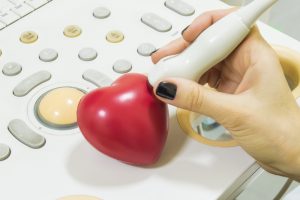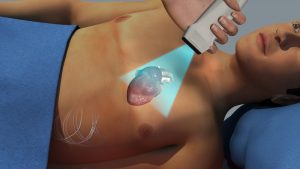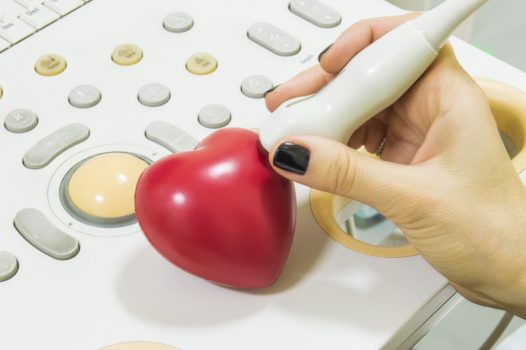Echocardiography is a test procedure used to produce echocardiogram, also known as the cardiac echo. An echocardiogram is the live image of your heart, created using high-frequency sound waves or ultrasound. This test allows your doctor to check the functioning of your heart and its valves.
Echocardiography has become a routine practice in the diagnosis if any patient suspects any heart problems. These tests are performed by cardiac sonographers, cardiac physiologists or physicians specializing in echocardiography. This test can often be referred to as diagnostic cardiac ultrasound.

What is an echocardiogram?
An echocardiogram helps especially after a heart arrest in determining the health of the heart’s muscles. This test can also reveal heart defects in unborn babies. An echo uses the ultrasound waves to create pictures of your heart’s chambers, valves, walls and the blood vessels attached to your heart. An echo can’t harm you.
It helps us to spot:
- Blood clots in the center, if any.
- Fluids present in the sac around the heart.
- Problems with the central artery connected to the heart, aorta.
Why Do People Need An Echo Test?
Your doctor uses this test to check the heart’s functioning. This test helps you to find out:
- Size and shape of your heart.
- Size, thickness, and movement of your heart’s walls.
- Heart movements.
- Pumping strength of your heart.
- Tracking the functioning of your heart valves.
- The condition of your heart valves.
- The passage of your heart valves.
- A tumor or an infection in your heart valves.
- An abnormal hole between the chambers of your heart.
- Problems with the outer lining of your heart.
- An issue with the large blood vessels of your heart.
Types Of Echocardiograms
There are different types of echocardiograms:
- Transthoracic Echocardiogram: This is the most common type and also painless. A device named transducer is placed on your chest, and ultrasound waves will be sent through to the heart. This way the computer interprets the sound waves and thus produces live images of your heart on the monitor.
- Transesophageal Echocardiogram: If transthoracic echocardiogram does not produce any images, a transesophageal echocardiogram will be recommended by your doctor. In this procedure, your doctor allows a flexible tube inside your mouth and passes it through the esophagus. This hose connects your throat to the stomach. Now, the transducer stays behind your heart which enables the computer to interpret and produce images your heart.
- Stress Echocardiogram: This type of echocardiogram is conducted after your body has exercised so that your doctor can check how your heart functions under stress. This procedure uses traditional transthoracic echocardiography.
- Three-dimensional Echocardiogram: This procedure uses transthoracic echocardiography or transesophageal echocardiography to produce three-dimensional images of your heart. It captures images of your heart from different angles. It is primarily used for heart valve surgery or heart diagnosis for children.
- Fetal Echocardiogram: This procedure is used on pregnant women to check the heart conditions of the unborn child/fetus. The transducer is placed on woman’s belly to check for any problems. This procedure is considered safer than x-rays.
Related Article: Sleep Apnea Types Causes and Treatments
Risks Involved
- Taking an echocardiogram is painless and harmless. However, there are some risks involved with only certain types of an echocardiogram. Echocardiograms are the safest source of all. It is not as harmful as x-rays since x-rays use radiations.
- A transthoracic echocardiogram has no risk. But there will be a little discomfort during the removal of electrodes from your skin. This procedure feels like removing a band-aid and nothing more.

Heart Treatment - During a transesophageal echocardiography, there is rare chance for the tube to scrap the side of the esophagus which causes irritation and may lead to a sore throat.
- In the stress echocardiography, the exercises or medications performed to raise the heartbeat could cause an irregular heartbeat temporarily. The risk is however minimized due to the supervision of the procedure.
Dr. Atif Sohail, who operates an Arlington Sleep Apnea Clinic, says, “Only your cardiologist can determine if you need an echocardiogram or not. You are more likely to undergo this test if you have suffered a heart stroke or a heart attack. This test can also be an option if your doctor speculates that you are enduring from other types of cardiovascular ailments, such as pulmonary hypertension or abnormal heart valves. Echocardiography requires a little or no time for recovery. It is an outpatient procedure. However, while undergoing transesophageal echocardiography, you may experience some throat discomfort after the test. Depending on the results, your doctor may order you to have additional testing.”
References:
- https://en.wikipedia.org/wiki/Echocardiography
- http://heartandsleepclinics.com/echocardiography/
- https://www.healthline.com/health/echocardiogram#overview1

